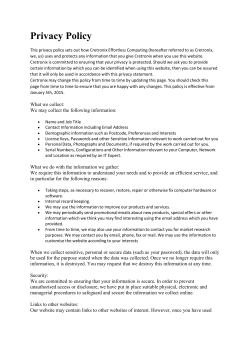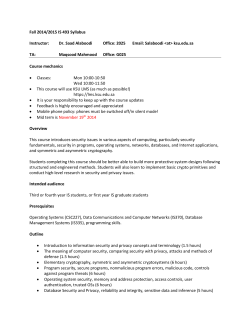
Privacy by Design in Federated Identity Management
Privacy by Design in Federated Identity Management Interpreting Legal Privacy Requirements for FIM and Comparing Risk Mitigation Models 2015 International Workshop on Privacy Engineering – IWPE’15 - MAY 21, 2015 - SAN JOSE, CA Rainer Hörbe, presenter Identinetics GmbH, Austria rh@identinetics.com Walter Hötzendorfer, co-author Centre for Computers and Law University of Vienna, Austria walter.hoetzendorfer@univie.ac.at Overview FIM usage: why, who, where? FIM-related privacy risks Motivation for this project Approach Findings FIM Usage Why Scalability: registration cost Interoperability: attribute semantics, trust policies Compliance: Loss of control across many silos Who Independent entities with common interests. (Supply chains, government agencies, R&E institutions, enterprise group members, professional networks, markets with roaming agreements.) Where eduGAIN, airlines, defense supply chains, government extranets, G2C/G2B services, .. Edge Mobile SIM, social networks, Cases centralized (single IDP) federations. FIM-Related Privacy Risks Due to FIM: Observability of behavior by central instances Linkabilty by introducing common identifiers Impersonation by Identity/Credential Providers or because of weaknesses in SSO mechanism Due to the lack of FIM with PbD Linkabilty by reusing identifying attributes Impersonation caused by password reuse Privacy Risks Unrelated to FIM Linkability Identifying contents across services Services integration/large privacy domains Observability Device fingerprinting IP-address Impersonation Weak endpoint security Poor crypto Motivation and Scope - FIM Projects featuring cross-sector federation (smart cities, citizen eIDs, B2B across supply chains) - How to handle the increased privacy risk considering legal requirements, cost, complexity, convenience, feasibility? - Scope limited on WebSSO use case (SAML, OpenID Connect) - Focus on Observability and Linkability Approach to Understand Requirements 1 Lex PP 2 PP .. Privacy Principles Legal sources PDR .. Privacy by Design Requ. BR PDR 3 777 777 7 FIM models 4 AR BR .. Business Requirements AR .. Architectural Requirements Privacy Principles PP1 Fairness + lawfulness PP2 Final purpose PP3 Proportionality PP4 Data quality PP5 Information security PP6 Openness + transparency PP7 Individual participation PP8 Accountability Privacy by Design Rules PDR1 Minimal identification PDR2 Disclose/need to know PDR3 Limited Linkability PDR4 Transparency + user control PDR5 Information security X X X X X Privacy by Design Rules PDR1 Minimal identification PDR2 Disclose/need to know PDR3 Limited Linkability PDR4 Transparency + user control PDR5 Information security Architectural Requirements X AR1 Limited observability X Existing Implementations AR2 Limited linkability X AR3 No unauthorized aggregation X AR4 Constrained linking X AR5 Consent handling X AR6 No supreme instance X AR7 Minimal attribute release X AR8 Unique identification Business Requirements BR1 Allow limited linking Privacy by Design Rules PDR1 Minimal identification PDR2 Disclose/need to know PDR3 Limited Linkability PDR4 Transparency + user control PDR5 Information security Architectural Requirements X AR1 Limited observability X Existing Implementations AR2 Limited linkability X AR3 No unauthorized aggregation X AR4 Constrained linking X AR5 Consent handling X AR6 No supreme instance X AR7 Minimal attribute release X AR8 Unique identification Business Requirements BR1 Allow limited linking The Problem Children Organizational Controls Attribute-Based Credentials Late Binding AR1 Limited observability Proxy Pool AR2 Limited linkability User-based IdPs AR3 No unauthorized aggregation AR4 Constrained linking AR5 Consent handling AR6 No supreme instance AR7 Minimized attribute release AR8 Unique identification Constrained Logging Proxy Blind Proxy Models for Limited Observability: (2) Attribute-Based Credentials ABCs provide assertions to the RP without the IdP knowing the actual RPs. Pro: Strong technical control. Con: (a) No implementation in mainstream products; lack of deployment profiles for SAML or OpenID Connect; (b) IdP business model; (c) performance; (d) Increased complexity. Models for Limited Observability: (3) Late Binding/Federated Credentials Credential-only federation (CSPs with brokers, or U2F tokens) rely on the separation between credential service assurance and identity assurance. Attributes are not released by the IdP, but obtained by the RP. Pro: Straightforward architecture that goes well with existing technology based on common SAML profiles. Credential providers have only a minor privacy risk. Con: (a) Less business value because attributes are collected per RP; (b) Identifying attributes like name, residential and e-mail addresses could enable linking. Models for Limited Observability: (6) Constrained Logging Proxy Log Server front channel message flow IdP Proxy RP Web Browser (passive client) The proxy stores log files only in a separate, well-protected system for a very limited time. Pro: Has been implemented without changes to FIM protocols. Con: While an adversary could cause only limited damage with a single data breach, a complete take-over of the proxy would compromise the privacy goal. Models for Limited Observability: (7) Blind Proxy root certificate one-time certificates CA front channel message flow IdP Blind Proxy RP Web Browser (passive client) end-to-end encrypted channel for attributes Pro: It proposes reasonably strong technical control, works with any credential technology and is fairly easy to fit into hub-and-spoke federations. Con: (a) Requires (small) extension to existing SAML and OIDC implementations. (b) It requires RPs to participate in a considerably large anonymity set. The Problem Children AR1 Limited observability AR2 Limited linkability AR3 No unauthorized aggregation AR4 Constrained linking AR5 Consent handling AR6 No supreme instance AR7 Minimized attribute release AR8 Unique identification Approaches for Limited Linkability Between Privacy Domains • • Unique Identifiers limited in scope: • Pairwise identifiers (IDP - RP) • Group or sector-specific identifiers Proxy attributes for identifying attributes: • Blind „reverse proxy“ for e-mail and jabber • User-selected pseudonyms for display names • Virtual credit cards, crypto-currencies for payments • PO-boxes etc. for physical shipment The Problem Children AR1 Limited observability AR2 Limited linkability AR3 No unauthorized aggregation AR4 Constrained linking AR5 Consent handling AR6 No supreme instance AR7 Minimized attribute release AR8 Unique identification Approaches for Constrained Linking (Between Privacy Domains) • • Types of link constraints: • A group of privacy domains (>=2) • By direction (i.e. unidirectional) • Temporal (e.g. until expiry or revocation) Examples: • Austrian eID with sector-specific identifiers encrypted for another sector’s target application • Mediated links in a blind proxy model: All access via proxy is encrypted end-to-end, except the identifier that is mapped by the proxy. Conclusions • Increased privacy risks introduced by FIM can be mitigated with technical controls. • Effort to implement controls for limited observability varies with the strength of the controls. • Limited likability with pairwise identifiers is current practice. However, identifying attributes are left out of the equation. There is room for improvement with moderate effort. Blind Proxy Profiles & Implementations - SAML PEFIM Profile https://kantarainitiative.org/confluence/x/-wIxB - PEFIM Proxy reference implementation http://github.com/its-dirg/pefim-proxy_docker/ - PEFIM IDP & SP implementations - PySAML2 https://github.com/its-dirg/pefim_sp https://github.com/its-dirg/pefim_idp - Shibboleth Will be available soon at shibboleth.net - OpenAM on request from cryptas.com
© Copyright 2025











